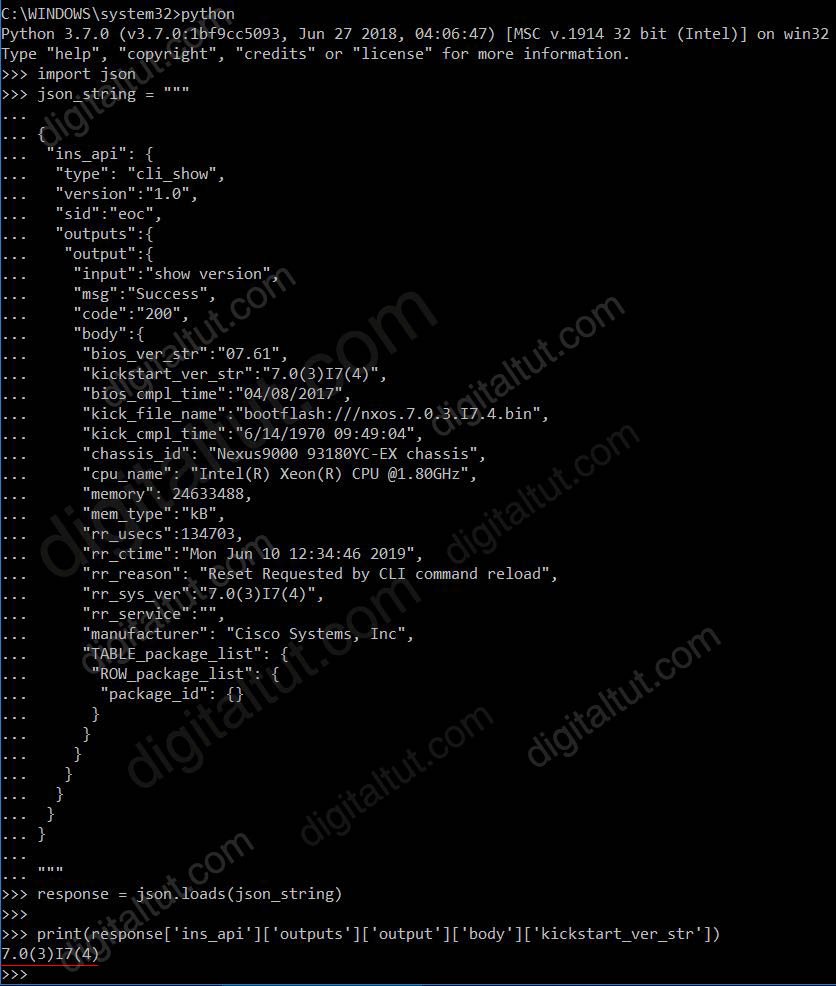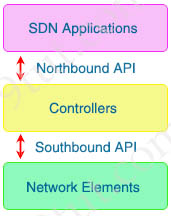Automation Questions 2
Question 1
Explanation
The words “try” and “except” are Python keywords and are used to catch exceptions. For example:
try: print 1/0 except ZeroDivisionError: print "Error! We cannot divide by zero!!!"
Question 2
Explanation
If we have a JSON string, we can parse it by using the json.loads() method so we don’t need to have a response server to test this question. Therefore, in order to test the result above, you can try this Python code:
import json
json_string = """
{
"ins_api": { <!!!Please copy the code above and put here. We omitted it to save some space!!!>
}
}
"""
response = json.loads(json_string)
print(response['ins_api']['outputs']['output']['body']['kickstart_ver_str'])
And this is the result:

Note:
+ If you want to run the full code in this question in Python (with a real HTTP JSON response), you must first install “requests” package before “import requests”.
+ The error “NameError: name ‘json’ is not defined” is only shown if we forgot the line “import json” in Python code -> Answer A is not correct.
+ We only see the “KeyError” message if we try to print out an unknown attribute (key). For example:
print(response['ins_api']['outputs']['output']['body']['unknown_attribute'])

+ Triple quotes (“””) in Python allows strings to span multiple lines, including verbatim NEWLINEs, TABs, and any other special characters.
Question 3
Explanation
Cisco IOS XE supports the Yet Another Next Generation (YANG) data modeling language. YANG can be used with the Network Configuration Protocol (NETCONF) to provide the desired solution of automated and programmable network operations. NETCONF(RFC6241) is an XML-based protocol that client applications use to request information from and make configuration changes to the device. YANG is primarily used to model the configuration and state data used by NETCONF operations.
Note: Although NETCONF also uses XML but XML is not a data modeling language.
Question 4
Explanation
The 404 (Not Found) error status code indicates that the REST API can’t map the client’s URI to a resource but may be available in the future. Subsequent requests by the client are permissible.
Reference: https://restfulapi.net/http-status-codes/
Question 5
Explanation
A 401 error response indicates that the client tried to operate on a protected resource without providing the proper authorization. It may have provided the wrong credentials or none at all.
Note: A 4xx code indicates a “client error” while a 5xx code indicates a “server error”.
Reference: https://restfulapi.net/http-status-codes/
Question 6
Question 7
Explanation
The Southbound API is used to communicate with network devices.

Question 8
Explanation
To enable the action of printing data directly to the local tty when an Embedded Event Manager (EEM) applet is triggered, use the action puts command in applet configuration mode.
The following example shows how to print data directly to the local tty:
| Router(config-applet)# event manager applet puts Router(config-applet)# event none Router(config-applet)# action 1 regexp “(.*) (.*) (.*)” “one two three” _match _sub1 Router(config-applet)# action 2 puts “match is $_match” Router(config-applet)# action 3 puts “submatch 1 is $_sub1” Router# event manager run puts match is one two three submatch 1 is one Router# |
The action puts command applies to synchronous events. The output of this command for a synchronous applet is directly displayed to the tty, bypassing the syslog.
Reference: https://www.cisco.com/c/en/us/td/docs/ios-xml/ios/eem/command/eem-cr-book/eem-cr-a1.html
Question 9
Explanation
JSON data is written as name/value pairs.
A name/value pair consists of a field name (in double quotes), followed by a colon, followed by a value:
“name”:”Mark”
JSON can use arrays. Array values must be of type string, number, object, array, boolean or null. For example:
{
“name”:”John”,
“age”:30,
“alive”:true,
“cars”:[ “Ford”, “BMW”, “Fiat” ]
}
Question 10
Explanation
Agentless tool means that no software or agent needs to be installed on the client machines that are to be managed. Ansible is such an agentless tool. In contrast to agentless tool, agent-based tool requires software or agent to be installed on the client (-> Answer D is not correct).
In agentless tool, the master and slave nodes can communicate directly without the need of high-level language interpreter but agent-based tool requires interpreter to be installed on both master and slave nodes -> Answer C is not correct.
An agentless tool uses standard protocols, such as SSH, to push configurations down to a device (and it can be considered a “messaging system”).
Agentless tools like Ansible can directly communicate to slave nodes via SSH -> Answer B is not correct.
Therefore only answer A left. In this answer, “Messaging systems” should be understood as “additional software packages installed on slave nodes” to control nodes. Agentless tools do not require them.
Question 11
Explanation
Yet Another Next Generation (YANG) is a language which is only used to describe data models (structure). It is not XML or JSON.
Question 12
Explanation
With Synchronous ( sync yes), the CLI command in question is not executed until the policy exits. Whether or not the command runs depends on the value for the variable _exit_status. If _exit_status is 1, the command runs, if it is 0, the command is skipped.



Question 10
Which statement about agent-based versus agentless configuration management tools is true?
A. Agentless tools require no messaging systems between master and slaves.
B. Agentless tools use proxy nodes to interface with slave nodes.
C. Agent-based tools do not require a high-level language interpreter such as Python or Ruby on slave nodes.
D. Agent-based tools do not require installation of additional software packages on the slave nodes.
Answer: C (should be A)
Explanation
Agentless tool means that no software or agent needs to be installed on the client machines that are to be managed. Ansible is such an agentless tool. In contrast to agentless tool, agent-based tool requires software or agent to be installed on the client. Therefore the master and slave nodes can communicate directly without the need of high-level language interpreter.
According to your explanation,
-agentless tool:require messaging systems between master and slaves
-agent-based tool:not require a high-level language interpreter
right?seems C is correct…
which answer is correct
Question 10
Which statement about agent-based versus agentless configuration management tools is true?
A. Agentless tools require no messaging systems between master and slaves.
B. Agentless tools use proxy nodes to interface with slave nodes.
C. Agent-based tools do not require a high-level language interpreter such as Python or Ruby on slave nodes.
D. Agent-based tools do not require installation of additional software packages on the slave nodes.
I have seen different answers for Q 10 so not sure if anyone could help
D
A
and offcourse C here
not sure which is correct
Question 10:
Agent based tools needs DSL to be installed which is a high level language interpreter
However, I’m not sure about the meaning of “no messaging system”… does SSH can be classified as messaging system?
why i can’t find questions ?1 only answers !!
What is question for #11?
sorry, i mean for #12?
Question 10
Which statement about agent-based versus agentless configuration management tools is true?
A. Agentless tools require no messaging systems between master and slaves.
B. Agentless tools use proxy nodes to interface with slave nodes.
C. Agent-based tools do not require a high-level language interpreter such as Python or Ruby on slave nodes.
D. Agent-based tools do not require installation of additional software packages on the slave nodes.
Correct answer C
Explanations:
A. (Incorrect) Agentless tools such as Ansible do need SSH (messaging system) between master and slave otherwise how will they communicate.
B. (Incorrect) only agent-based tools use proxy agents on the clients.
C (Correct) Agent-based tools such as Chef, Puppet, SaltStack require instillation of special software (agent) on the client nodes. The server node then talks with the agent directly and there is no need of a high-level language interpreter such as Python or Ruby on slave nodes.
D. (Incorrect) Agent-based tools such as Chef, Puppet, SaltStack do require installation of additional software packages (agents) on the slave nodes.
Q10:
– C is wrong, e.g. Puppet and Chef are agent-based tools but they use Ruby.
– A is better answer, by “messaging system” they probably mean a specialized platform, e.g. 0MQ used by SaltStack. We shouldn’t consider SSH, SNMP etc. as messaging systems.
Master and Slave nodes are Agent-based configuration terms. There’s no masters or slaves with Ansible. So answer is A
@I.L.I., @Genius: Yes, after reviewing Q.10, we believe the correct answer is A and we update it!
Its very difficult …. dont know how can the paper be cleared.. Totally new stuff for network engineers ..
Question 10
Please verify Answer should be letter C.
Which statement about agent-based versus agentless configuration management tools is true?
A. Agentless tools require no messaging systems between master and slaves.
B. Agentless tools use proxy nodes to interface with slave nodes.
C. Agent-based tools do not require a high-level language interpreter such as Python or Ruby on slave nodes.
D. Agent-based tools do not require installation of additional software packages on the slave nodes.
▪ Agent-based configuration: With agent-based tools, an agent must be installed on every device that the configuration management tool will manage.
▪ Agentless configuration: Agentless tools do not require that an agent be installed on every device; instead, they communicate via SSH or another API that a device supports.
https://www.ciscopress.com/articles/article.asp?p=3100057&seqNum=3
Dont see the questions on this page, help !
Q12
I think that is the correct answer is:
C. $_string_result
ction 1.1 puts nonewline “Do you wish to continue [Y/N]”
action 1.2 gets response
action 1.3 string toupper “$response”
action 1.4 string match “$_string_result” “Y”
action 2.0 if $_string_result eq 1
action 2.1 cli command “enable”
action 2.2 cli command “show running-config”
action 2.3 puts $_cli_result
action 2.4 cli command “exit”
action 2.9 end
Hi folks!!
Who has taken the Exam recently?
Are all the questions and labs in this material??
I would appreciate your feedback